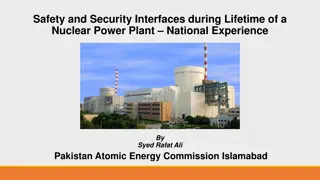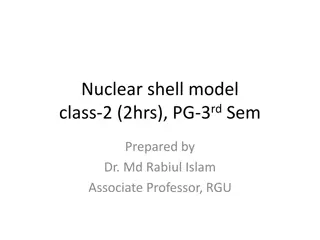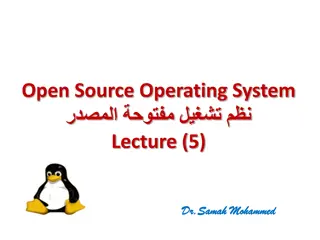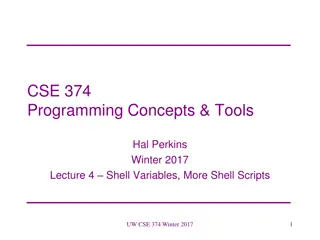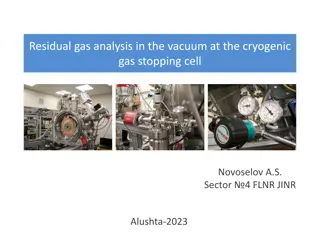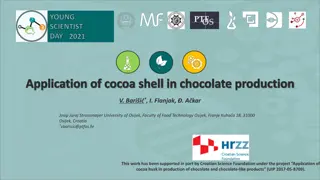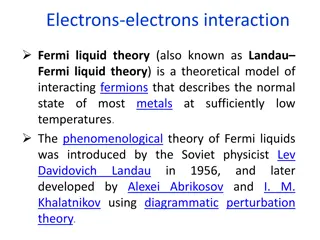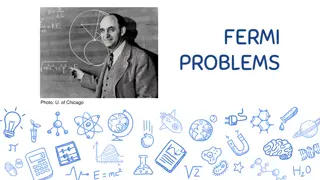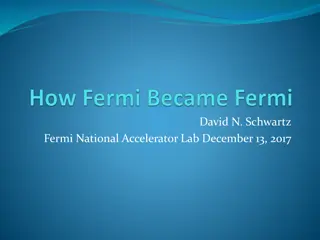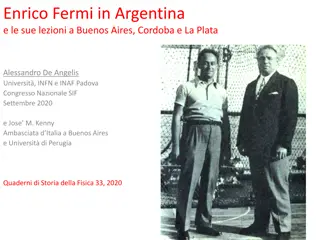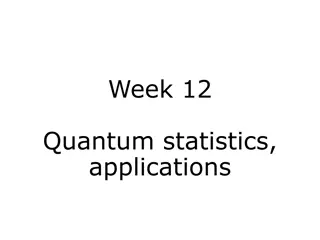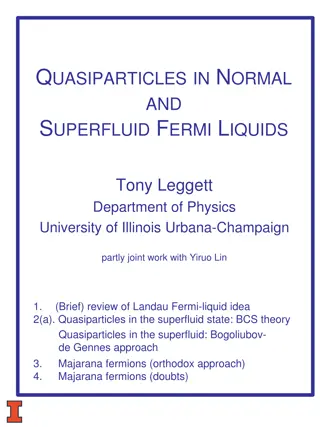Nuclear Models: Fermi Gas Model and Shell Model Overview
Explore the Fermi Gas Model, an early effort to capture quantum effects in nuclei using free protons and neutrons within a spherically symmetric well. Understand the principles behind nucleon occupation, Fermi levels, and binding energies. Compare charge independence in experimental observations and discover the implications for heavy nuclei.
Download Presentation

Please find below an Image/Link to download the presentation.
The content on the website is provided AS IS for your information and personal use only. It may not be sold, licensed, or shared on other websites without obtaining consent from the author.If you encounter any issues during the download, it is possible that the publisher has removed the file from their server.
You are allowed to download the files provided on this website for personal or commercial use, subject to the condition that they are used lawfully. All files are the property of their respective owners.
The content on the website is provided AS IS for your information and personal use only. It may not be sold, licensed, or shared on other websites without obtaining consent from the author.
E N D
Presentation Transcript
PHYS 3446 Lecture #9 Monday, Oct. 3, 2016 Dr. Jae Jae Yu Nuclear Models Fermi Gas Model Shell Model Collective Model Super-deformed Nuclei Nuclear Radiation Alpha decay Beta decay Monday, Oct. 3, 2016 PHYS 3446, Fall 2016 1
Announcement First term exam Date and time: 2:30 3:50pm, Monday, Oct. 10 Location: SH125 Covers: Ch 1 Ch 3 or what we finish Wednesday, Oct. 5, + Appendix A Can bring your calculator but no phone or computer can be used as a replacement First quiz results Class average: 56.5/120 Equivalent to 47.1/100 Class top score: 89/120 Monday, Oct. 3, 2016 PHYS 3446, Fall 2016 2
Nuclear Models: Fermi Gas Model An early attempt to incorporate quantum effects Assumes nucleus as a gas of free protons and neutrons confined to the nuclear volume The nucleons occupy quantized (discrete) energy levels Nucleons are moving inside a spherically symmetric well with the range determined by the radius of the nucleus Depth of the well is adjusted to obtain correct binding energy Protons carry electric charge Senses slightly different potential than neutrons Monday, Oct. 3, 2016 PHYS 3446, Fall 2016 3
Nuclear Models: Fermi Gas Model Nucleons are Fermions (spin particles) so Obey Pauli exclusion principle Any given energy level can be occupied by at most two identical nucleons opposite spin projections For a greater stability, the energy levels fill up from the bottom up to the Fermi level Fermi level: Highest, fully occupied energy level (EF) Binding energies are given as follows: BE of the last nucleon= EF since no Fermions above EF In other words, the level occupied by Fermion reflects the BE of the last nucleon Monday, Oct. 3, 2016 PHYS 3446, Fall 2016 4
Nuclear Models: Fermi Gas Model Experimental observations show BE is charge independent If the well depth is the same for p and n, BE for the last nucleon would be charge dependent for heavy nuclei (Why?) Since there are more neutrons than protons, neutrons sit higher EF Monday, Oct. 3, 2016 PHYS 3446, Fall 2016 5
Same Depth Potential Wells Proton Well Neutron Well n F E p F E Nuclear -decay e + + n p e Monday, Oct. 3, 2016 PHYS 3446, Fall 2016 6
Nuclear Models: Fermi Gas Model Experimental observations show BE is charge independent If the well depth is the same for p and n, BE for the last nucleon would be charge dependent for heavy nuclei (Why?) Since there are more neutrons than protons, neutrons sit higher EF But experiments observed otherwise EF must be the same for protons and neutrons. How do we make this happen? Make protons move to a shallower potential well What happens if this weren t the case? Nucleus is unstable. All neutrons at higher energy levels would undergo a -decay and transition to lower proton levels Monday, Oct. 3, 2016 PHYS 3446, Fall 2016 7
Fermi Gas Model: EF vs nF 22 F F E p = = 2 p mE Fermi momentum: Volume for momentum space up to Fermi level Total volume for the states (kinematic phase space) Proportional to the total number of quantum states in the system 4 3 3 m F F 4 = 3 F V p p 3 F 2 4 4 ( ) 1 2! 3 3 F 3 = = V V = r A p A r p TOT V 0 0 F p 3 F x p Using Heisenberg s uncertainty principle: The minimum volume associated with a physical system becomes The nF that can fill up to EF is nF= 2 2p! ( ) ( ) 3 Vstate= 2p! VTOT 2 3 4p 3 2 3=4 r0pF ! A r0pF ( ) 3= 9pA ( ) 3 2p! Monday, Oct. 3, 2016 Why? PHYS 3446, Fall 2016 8
Fermi Gas Model: EF vs nF Let s consider a nucleus with N=Z=A/2 and assume that all states up to Fermi level are filled A N Z = = = or 2 What do you see about pF above? Fermi momentum is constant, independent of the number of nucleons 2 F p m= 2.32 2 940 197 MeV fm E = 33 MeV F 1.2 2 fm Using the average BE of -8MeV, the depth of potential well (V0) is ~40MeV Consistent with other findings This model is a natural way of accounting for a4 term in Bethe-Weizsacker mass formula Monday, Oct. 3, 2016 PHYS 3446, Fall 2016 9
Nuclear Models: Shell Model Exploit the success of atomic model Uses orbital structure of nucleons Electron energy levels are quantized Limited number of electrons in each level based on the available spin and angular momentum configurations For nth energy level, l angular momentum (l<n), one expects a total of 2(2l+1) possible degenerate states for electrons Monday, Oct. 3, 2016 PHYS 3446, Fall 2016 10
Atomic Shell Model Reminder Orbits and energy levels an electron can occupy are labeled by Principle quantum number: n n can only be integer For given n, energy degenerate orbital angular momentum: l The values are given from 0 to n 1 for each n For any given orbital angular momentum, there are (2l+1) sub-states: ml ml=-l, -l+1, , 0, 1, , l 1, l Due to rotational symmetry of the Coulomb potential, all these sub-states are degenerate in energy Since electrons are fermions w/ intrinsic spin angular momentum , Each of the sub-states can be occupied by two electrons So the total number of state is 2(2l+1) 1 2! Monday, Oct. 3, 2016 PHYS 3446, Fall 2016 11
Nuclear Models: Shell Model Exploit the success of atomic model Uses orbital structure of nucleons Electron energy levels are quantized Limited number of electrons in each level based on available spin and angular momentum configurations For nth energy level, l angular momentum (l<n), one expects a total of 2(2l+1) possible degenerate states for electrons Quantum numbers of individual nucleons are taken into account to affect the fine structure of spectra Monday, Oct. 3, 2016 PHYS 3446, Fall 2016 12
Nuclear Models: Shell Model Nuclei have magic numbers just like inert atoms Atoms: Z=2, 10, 18, 36, 54 Nuclei: N=2, 8, 20, 28, 50, 82, and 126; Z=2, 8, 20, 28, 50, and 82 Magic Nuclei: Nuclei with either N or Z a magic number Stable Doubly magic nuclei: Nuclei with both N and Z magic numbers Particularly stable (some examples?) Explains well the stability of nucleus Monday, Oct. 3, 2016 PHYS 3446, Fall 2016 13
Shell Model: Various Potential Shapes To solve the equation of motion in quantum mechanics, Schr dinger equation, one must know the shape of the potential Details of nuclear potential not well known A few shapes of potential energies tried out Infinite square well: Each shell can contain up to 2(2l+1) nucleons Monday, Oct. 3, 2016 PHYS 3446, Fall 2016 14
Nuclear Models: Shell Model Square well potential case Ns=2(2l+1) 2 2+6 2+6+10 2+6+10+14 2+6+10+14+18 2+6+10+14+18+22 NM 2 8 20 28 50 82 NT 2 8 18 32 50 72 n l=n-1 1 2 3 4 5 6 0 0,1 0,1,2 0,1,2,3 0,1,2,3,4 0,1,2,3,4,5 Monday, Oct. 3, 2016 PHYS 3446, Fall 2016 15
Shell Model: Various Potential Shapes To solve equation of motion in quantum mechanics, Schr dinger equation, one must know the shape of the potential Details of nuclear potential not well known A few models of potential tried out Infinite square well: Each shell can contain up to 2(2l+1) nucleons Can predict 2, 8 and 50 but no other magic numbers Three dimensional harmonic oscillator: Predicts 2, 8, 20, 40 and 70 Some magic numbers predicted 1 2m ( ) V r = 2 2 r Monday, Oct. 3, 2016 PHYS 3446, Fall 2016 16
Shell Model: Spin-Orbit Potential Central potential could not reproduce all magic numbers In 1940, Mayer and Jesen proposed a central potential + strong spin-orbit interaction w/ V = ( ) ! L ! V r -f r ( ) S TOT f(r) is an arbitrary empirical function of radial coordinates and chosen to fit the data For the spin-orbit interaction with the properly chosen f(r), a finite square well can split Reproduces all the desired magic numbers Spectroscopic notation: n L j Orbital angular momentum Orbit number Monday, Oct. 3, 2016 PHYS 3446, Fall 2016 17 Projection of total momentum
Predictions of the Shell Model Spin-Parity of large number of odd-A nuclei predicted well Nucleons are Fermions and obey Pauli exclusion principle Fill up ground state energy levels in pairs Ground state of all even-even nuclei have zero total angular momentum The shell model cannot predict stable odd-odd nuclei spins No prescription for how to combine the unpaired proton and neutron spins Monday, Oct. 3, 2016 PHYS 3446, Fall 2016 18
Predictions of the Shell Model Magnetic Moment of neutron and proton are 2.79 p 1.91 N n N Intrinsic magnetic moment of unpaired nucleons contribute to total magnetic moment of nuclei What does a deuteron consist of? = = 0.86 = 1.91 = 0.88 + 2.79 p n N N N D Measured value is For Boron (10B5) , the 5 neutrons and 5 protons have the same level structure: (1S1/2)2(1P3/2)3, leaving one of each unpaired proton and neutron in angular momentum l=1 state = 1.80 B = D N = N = + = + + 2.79 1.91 1.88 orbit N N N B p n N Measured value is Does not work well with heavy nuclei N Monday, Oct. 3, 2016 PHYS 3446, Fall 2016 19
Collective Model For heavy nuclei, shell model predictions do not agree with experimental measurements Especially in magnetic dipole moments Measured values of quadrupole moments for closed shells differ significantly with experiments Some nuclei s large quadrupole moments suggests significant nonspherical shapes The assumption of rotational symmetry in shell model does not seem quite right These deficiencies are somewhat covered through the reconciliation of liquid drop model and the Shell model Bohr, Mottelson and Rainwater s collective model, 1953 Monday, Oct. 3, 2016 PHYS 3446, Fall 2016 20
Collective Model Assumption Nucleus consists of hard core of nucleons in filled shells Outer valence nucleons behave like the surface molecules in a liquid drop Non-sphericity of the central core is caused by the surface motion of the valence nucleons Thus, in the collective model, the potential is a shell model with a spherically asymmetric potential Aspherical nuclei can produce additional energy levels upon rotation while spherical ones cannot Important predictions of the collective model: Existence of rotational and vibrational energy levels in nuclei Accommodate decrease of spacing between first excite state and the ground level for even-even nuclei as A increases, since moment of inertia increases with A Spacing is largest for closed shell nuclei, since they tend to be spherical Monday, Oct. 3, 2016 PHYS 3446, Fall 2016 21
Super-deformed Nuclei Nuclei tend to have relatively small intrinsic spins Particularly stable nuclei predicted for A between 150 and 190 with spheroidal character Semi-major axis about a factor of 2 larger than semi-minor Heavy ion collisions in late 1980s produced super-deformed nuclei with angular momentum of The energy level spacing of these observed through photon radiation seem to be fixed Different nuclei seem to have identical emissions as they spin down Problem with collective model and understanding of strong pairing of nucleon binding energy Understanding nuclear structure still in progress Monday, Oct. 3, 2016 PHYS 3446, Fall 2016 22
Nuclear Radiation: Alpha Decay Represents the disintegration of a parent nucleus to a daughter through an emission of a He nucleus Reaction equation is A Z X Y +4 2 4 2 A Z He -decay is a spontaneous fission of the parent nucleus into two daughters of highly asymmetric masses Assuming parent at rest, from the energy conservation 2 P M c = D D M c T + + 2 2 + M c T Re-organizing the terms, we obtain T T + = ( M ) 2 2 = Mc M M c D P D Monday, Oct. 3, 2016 PHYS 3446, Fall 2016 23
Nuclear Radiation: Alpha Decay Since electron masses cancel, we could use atomic mass expression T T + = , M A Z M A ( ) ( ) ( ) ( ) 2 Q 4, 2 4,2 Z M c D This is the definition of the disintegration energy or Q- value Difference of rest masses of the initial and final states Q value is equal to the sum of the final state kinetic energies Energy lost during the disintegration process For non-relativistic particles, KE are 1 2 1 2 2 2 = = T M v T M v D D D Monday, Oct. 3, 2016 PHYS 3446, Fall 2016 24
Nuclear Radiation: Alpha Decay Since the parent is at rest, from the momentum conservation D D M v M M = D v v = M v D MD= Ma, vD= va If , then We can write the relationship of KE and Q-value as 1 1 2 2 + + = T T D 2 M M 1 2 1 2 2 2 + = + = 2 + T T M v M v M v M v D D D D D M M M = D D T T T T Q D + M M M D D This means that T is unique for the given nuclei Direct consequence of 2-body decay of a parent at rest Monday, Oct. 3, 2016 PHYS 3446, Fall 2016 25
Nuclear Radiation: Alpha Decay KE of the emitted must be positive Thus for an -decay to occur, it must be an exorthermic process For a massive nuclei, the daughter s KE is M M M + 0, 0 M Q M M = = = - T Q T Q T Ta D D D ( ) Since , we obtain D M M Ta A-4 A 4 4 A 4 A T Q Q D Monday, Oct. 3, 2016 PHYS 3446, Fall 2016 26
Nuclear Radiation: Alpha Decay Most energetic -particles produced alone Parent nucleus decays to the ground state of a daughter and produces an -particle whose KE is the entire Q value Less energetic ones accompany photons mostly delayed Indicates quantum energy levels Parent decays to an excited state of the daughter after emitting an A Z X Y + 4 * 2 4 2 A Z He Daughter then subsequently de-excite by emitting a photon 4 * 2 A Z Y Y + 4 2 A Z Difference in the two Q values corresponds to the energy of the photon Monday, Oct. 3, 2016 PHYS 3446, Fall 2016 27
Nuclear Radiation: -Decay Example 240Pu94 decay reaction is 240 Pu 94 236 92 +4 2 U He particles are observed with 5.17MeV and 5.12 MeV Since We obtain the two Q-values 2405.17 5.26 236 A = Q T 4 A 2405.12 236 E = = 5.21 Q MeV MeV Q MeV MeV 1 2 Which yields photon energy of Consistent with experimental measurement, 45KeV Indicates the energy level spacing of order 100KeV for nuclei Compares to order 1eV spacing in atomic levels = = = 0.05 Q Q Q MeV 1 2 Monday, Oct. 3, 2016 PHYS 3446, Fall 2016 28
Discovery of Alpha and Beta Radiations After Bacquerel s discovery of uranium effect on photo-films in 1896 The Curies began study of radio activity in 1898 Rutherford also studied using a more systematic experimental equipments in 1898 Measured the currents created by the radiations While Bacquerel concluded that rays are observed in different levels Rutherford made the observation using electrometer and determined that there are at least two detectable rays Named and rays Monday, Oct. 3, 2016 PHYS 3446, Fall 2016 29
Nuclear Radiation: -Decays Three kinds of -decays Electron emission Nucleus with large Nn Atomic number increases by one Nucleon number stays the same Positron emission Nucleus with many protons Atomic number decreases by one Nucleon number stays the same You can treat nuclear reaction equations algebraically The reaction is valid in the opposite direction as well Any particle moved over the arrow becomes its anti particle A Z X Y e+ + e + A Z X + 1 A Z Y e+ 1 A Z A Z X + Y e 1 A Z + A Z Y 1 A Z X Monday, Oct. 3, 2016 PHYS 3446, Fall 2016 30
Nuclear Radiation: -Decays Electron capture Nucleus with many protons Absorbs a K-shell atomic electron Proton number decreases by one Causes cascade X-ray emission from the transition of remaining atomic electrons For -decay: A=0 and | Z|=1 e 1 A Z + A Z Y X Monday, Oct. 3, 2016 PHYS 3446, Fall 2016 31
Nuclear Radiation: -Decays Initially assumed to be 2-body decay From energy conservation E = Y e e + A Z X + 1 A Z Y + = 2 + + E E E T m c X Y e e Since lighter electron carries most the KE ( e X Y e Results in a unique Q value as in -decay. In reality, electrons emitted with continuous E spectrum with an end- point given by the formula above Energy conservation is violated!!!! ) ( ) = Q T 2 = 2 = m m m c T T E E m c Q Y X Y e Y End-point Monday, Oct. 3, 2016 PHYS 3446, Fall 2016 32
Nuclear Radiation: -Decays Angular momentum is also in trouble In -decays total number of nucleons is conserved Recall | A|=0 and | Z|=1 in -decays? Electrons are fermions with spin Independent of any changes of an integer orbital angular momentum, the total angular momentum cannot be conserved How much does it always differ by? Angular momentum conservation is violated!!! 1 2! 1 2! Monday, Oct. 3, 2016 PHYS 3446, Fall 2016 33
Nuclear Radiation: -Decays In 1931 Pauli postulated an additional particle emitted in - decays No one observed this particle in experiments Difficult to detect First observation of e in 1956, in 1962 and in 1977 (direct 2000) Charge is conserved in -decays Electrically neutral Maximum energy of electrons is the same as the Q value Massless Must conserve the angular momentum Must be a fermion with spin This particle is called the neutrino (by Feynman) and expressed as 1 2! Monday, Oct. 3, 2016 PHYS 3446, Fall 2016 34
Nuclear Radiation: Neutrinos Have anti-neutrinos , just like other particles Neutrinos and anti-neutrinos are distinguished through the spin projection on momentum Helicity is used to distinguish them Left-handed (spin and momentum opposite direction) anti-electron-neutrinos are produced in -decays Right-handed electron-neutrinos are produced in positron emission e- is a particle and e+ is the anti-particle to e- is a particle and is the anti-particle to e e v e Monday, Oct. 3, 2016 PHYS 3446, Fall 2016 35
Decay Reaction Equations with Neutrinos Electron emission A X + 1 Z A Z + + e Y e Positron emission A X e + 1 Z A Z + + Y e Electron capture X + e e 1 A Z A Z + Y Monday, Oct. 3, 2016 PHYS 3446, Fall 2016 36
-Decays with neutrinos If the parent nucleus decays from rest, from the conservation of energy 2 p D D T M c 2 2 2 M c = + + + + + eT m c T m c e e e Thus the Q-value of a -decay can be written T T T p M ( ) + + = 2 2 = =Q M m m c Mc D D e e e e Electron emission can only occur if Q>0 Neglecting all small atomic BE, e emission can occur if ( ) ( , Q M A Z M A Z = ( ) ( , M A Z M A Z ( ( ) ) ) 2 + ) , 1 m m c e e 2 + , 1 0 c Monday, Oct. 3, 2016 PHYS 3446, Fall 2016 37
-Decays with neutrinos Since the daughter nucleus is much heavier than e or , the small recoil energy of daughter can be ignored Thus we can obtain This means that the energy of the electron is not unique and can be any value in the range The maximum electron kinetic energy can be Q This is the reason why the electron energy spectrum is continuous and has an end point (=Q) The same can apply to the other two -decays + eT T Q e 0 eT Q Monday, Oct. 3, 2016 PHYS 3446, Fall 2016 38
Particle Numbers Baryon numbers: A quantum number assigned to baryons (particles consist of quarks) Mostly conserved in many interactions Baryons: +1 Anti-baryons: -1 Protons and neutrons are baryons with baryon number +1 each Lepton numbers: A quantum number assigned to leptons (electrons, muons, taus and their corresponding neutrinos) Leptons: +1 Anti-leptons: -1 Must be conserved at all times under SM in each species Monday, Oct. 3, 2016 PHYS 3446, Fall 2016 39
Lepton Numbers Three charged leptons exist in nature with their own associated neutrinos e e These three types of neutrinos are distinct from each other muon neutrinos never produce other leptons than muons or anti-muons A Z X + + 1 A Z + Y + 1 A Z A Z + + X Y e + 1 A Z A Z + + X Y Monday, Oct. 3, 2016 PHYS 3446, Fall 2016 40
Lepton Numbers For electron neutrinos + 1 A Z A Z + + X Y e e + 1 A Z A Z + + X Y e + 1 A Z A Z + + X Y e For tau neutrinos + 1 A Z A Z + + X Y + 1 A Z A Z + + X Y e + 1 A Z A Z + + X Y Monday, Oct. 3, 2016 PHYS 3446, Fall 2016 41
Neutrino Mass What does neutrino mass do to the -spectrum? Smooth tail Sharp cut-off The higher end tail shape depends on the mass of the neutrino -spectrum could be used to measure the mass of neutrinos Very sensitive to the resolution on the device Most stringent direct limit is m <2eV/c2 Non-zero mass of the neutrino means Neutrino Oscillation: Mixing of neutrino species Monday, Oct. 3, 2016 PHYS 3446, Fall 2016 42
Weak Interactions -decay can be written at the nucleon level as: n e p e + p e + p + + n e + + n + e e Since neutrons are heavier than protons, they can decay to a proton in a free space On the other hand, protons are lighter than neutrons therefore they can only undergo a -decay within a nucleus Life time of a neutron is about 900sec This life time is a lot longer than nuclear reaction time scale 10-23 s or EM scale 10-16 s. This means that a -decay is a nuclear phenomenon that does not involve strong nuclear or EM forces Fermi postulated a new weak force responsible for - decay Monday, Oct. 3, 2016 PHYS 3446, Fall 2016 43
Weak Interactions Weak forces are short ranged How do we know this? Occurs in the nuclear domain Weakness of the strength is responsible for long life time seen in -decays Nucleus does not contain electrons Electrons in -decays must come from somewhere else Electrons are emitted without time delay The electron must come at the time of decay just like the alphas from a nuclear disintegration -decay can be considered to be induced by the weak force Monday, Oct. 3, 2016 PHYS 3446, Fall 2016 44
Weak Interactions The transition probability per unit time, the width, can be calculated from perturbation theory using Fermi s Golden rule 2 P H = ( ) 2 E fi f Where the weak interaction Hamiltonian is ( ) x H ( ) x = 3 * f = H f H i d x fi wk wk i Monday, Oct. 3, 2016 PHYS 3446, Fall 2016 45
Weak Interactions Based on -decay reaction equations, the Hwk must be a four fermionic states Hwk proposed by Fermi in 1933 is a four-fermion interaction or current-current interaction Relativistic Agreed rather well with experiments for low energy -decays Parity violation There are only left-handed neutrinos and right-handed anti-neutrinos A system is parity invariant if it does not change under inversion of spatial coordinates The spin The handedness, helicity, changes upon the spatial inversion since the direction of the motion changes while the spin direction does not Since there is no right handed neutrinos, parity must be violated in weak interactions ( ) ( ) = = = , r r L r p r p L p p Monday, Oct. 3, 2016 PHYS 3446, Fall 2016 46
Gamma Decays When a heavy nuclei undergo alpha and beta decays, the daughters get into an excited state Must either break apart Or emit another particle To bring the daughter into its ground state Typical energies of photons in -decays are a few MeV s These decays are EM interactions thus the life time is on the order of 10-16sec. Photons carry one unit of angular momentum Parity is conserved in this decay Monday, Oct. 3, 2016 PHYS 3446, Fall 2016 47
Assignments 1. Reading assignment: CH 4.3 2. End of the chapter problems: 3.2 3. Derive the following equations: Eq. 4.8 starting from conservation of energy Eq. 4.11 both the formula Due for these homework problems is next Monday, Oct. 16. Monday, Oct. 3, 2016 PHYS 3446, Fall 2016 48
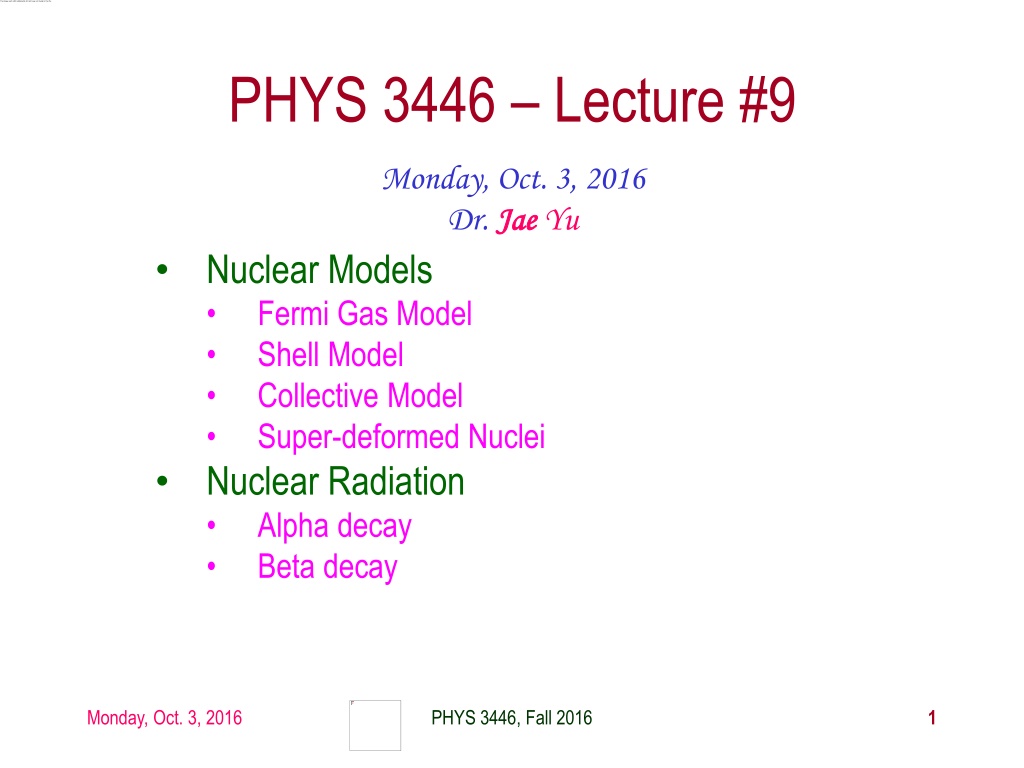
 undefined
undefined



